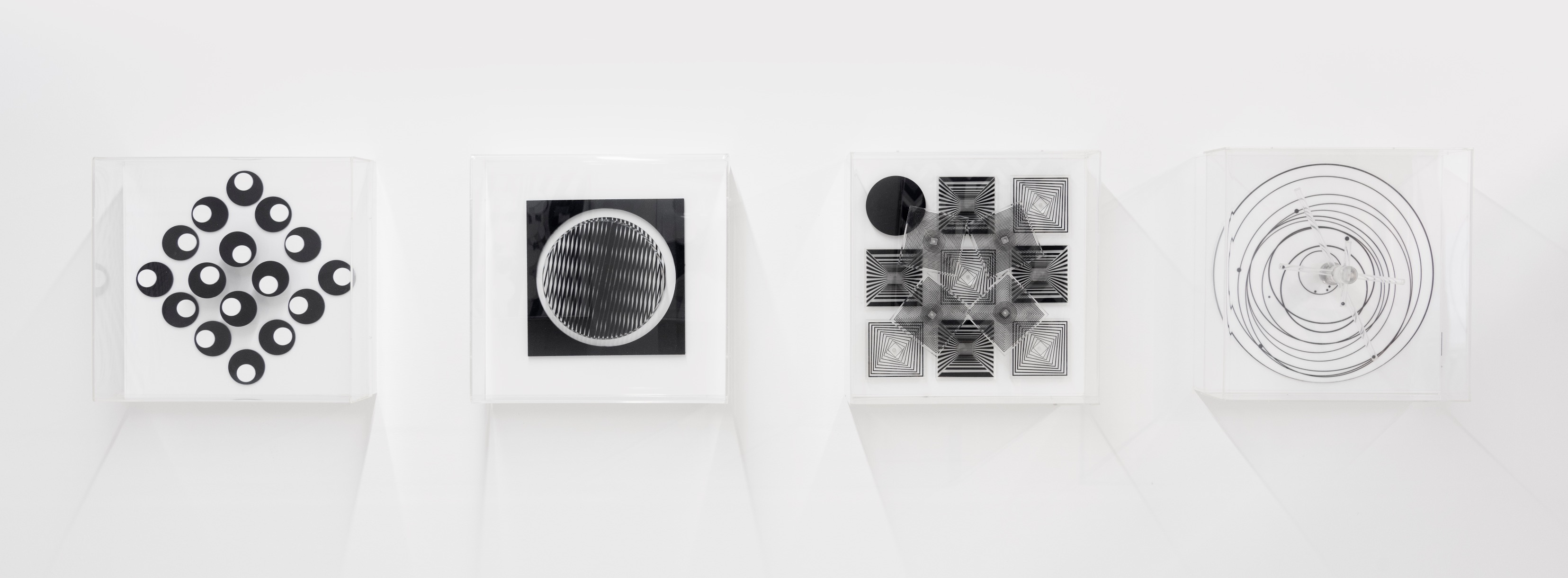Móviles homenaje

Móviles
Homenaje es una serie de cajas cinéticas de acrílico. Cada pieza está basada en
la investigación de artistas históricos que trabajaron el movimiento y sus
efectos ópticos a lo largo de la historia del arte.
Las piezas se reaporopian de ciertos elementos de cada uno de los artistas investigados, la apropiación no sólo es formal o estética sino además conceptual y cuestiona cómo sería desarrollar esas búsquedas que ellos realizaron históricamente en el contexto actual. ¿Cómo atravesaría la tecnología presente las obras de estos maestros?
Las piezas se reaporopian de ciertos elementos de cada uno de los artistas investigados, la apropiación no sólo es formal o estética sino además conceptual y cuestiona cómo sería desarrollar esas búsquedas que ellos realizaron históricamente en el contexto actual. ¿Cómo atravesaría la tecnología presente las obras de estos maestros?
Mobile Tribute is a series of kinetic sculptures. Each piece is based on the research of historical artists who worked the movement and its optical effects throughout the history of art.
Each of the pieces take some elements of each of the artists investigated, the appropriation is not only formal or aesthetic it's also conceptual and addresses questions about how they could have developed those searches today. How would the present technology go through the works of these Masters?
Each of the pieces take some elements of each of the artists investigated, the appropriation is not only formal or aesthetic it's also conceptual and addresses questions about how they could have developed those searches today. How would the present technology go through the works of these Masters?


La
primera de la serie es una obra que toma como punto de partida la obra
“Rotorelief” de Marcel Duchamp de 1935. La segunda, “Variación número 16”
agrega una nueva variación a las “15 variaciones sobre un mismo tema” de 1938
de Max Bill, desarrolla la investigación sobre el movimiento rotatorio de
ciertas figuras geométricas y su transformación, agrego ritmo, tiempo y compás.
En “Rotación para un color”, ”Distorsión”, “Frecuencia” y “Secuencia” investigo los estudios y trabajos de Jesus Rafael Soto y Carlos Cruz Diez específicamente los efectos producidos por la vibración visual de las tramas y las sucesiones de líneas, los cambios de orientación y sentido, agrego a dichos efectos visuales estáticos los que se generan con la utilización de dispositivos que producen movimientos mecánicos.
Las piezas “Rotaciones”, “Desplazamientos múltiples” y “Desplazamiento lumínico” ahondan las búsquedas de Martha Boto a los que incorporo técnicas como el grabado y luces led. Estas investigaciones teóricas formales y experimentales han contado con el apoyo y discusión de maestros cercanos a mí durante mi formación como Rogelio Pollesello, Julio Le Parc y Eduardo Rodríguez.
Mariana Villafañe
En “Rotación para un color”, ”Distorsión”, “Frecuencia” y “Secuencia” investigo los estudios y trabajos de Jesus Rafael Soto y Carlos Cruz Diez específicamente los efectos producidos por la vibración visual de las tramas y las sucesiones de líneas, los cambios de orientación y sentido, agrego a dichos efectos visuales estáticos los que se generan con la utilización de dispositivos que producen movimientos mecánicos.
Las piezas “Rotaciones”, “Desplazamientos múltiples” y “Desplazamiento lumínico” ahondan las búsquedas de Martha Boto a los que incorporo técnicas como el grabado y luces led. Estas investigaciones teóricas formales y experimentales han contado con el apoyo y discusión de maestros cercanos a mí durante mi formación como Rogelio Pollesello, Julio Le Parc y Eduardo Rodríguez.
Mariana Villafañe
The first of the series is a work that takes as a starting point the work “Rotorelief” by Marcel Duchamp of 1935. The second, “Variation Number 16” adds a new variation to the “15 variations on the same theme” of 1938 Max Bill and develops their search on the rotational movement of certain geometrical shapes and their transformation. I add rhythm, time and compass.
In “Rotation for a color”, “Distortion”, “Frequency” and “Sequence” I investigate the studies and works of Jesus Rafael Soto and Carlos Cruz Diez, specifically the effects produced by the visual vibration of geometric patterns, the repetition and the sequences of lines, the changes of orientation and direction. I add to those static visual effects more and new visual situations generated with the use of devices that produce mechanical movements.
The pieces “Rotations”, “Multiple Displacements” and “Luminous Movement” are deep in Martha Boto’s searches to which I incorporate techniques such as engraving and led lights. These formal and experimental investigations have had the support and discussion of teachers close to me during my training as Rogelio Pollesello, Julio Le Parc and Eduardo Rodriguez.
Mariana Villafañe
In “Rotation for a color”, “Distortion”, “Frequency” and “Sequence” I investigate the studies and works of Jesus Rafael Soto and Carlos Cruz Diez, specifically the effects produced by the visual vibration of geometric patterns, the repetition and the sequences of lines, the changes of orientation and direction. I add to those static visual effects more and new visual situations generated with the use of devices that produce mechanical movements.
The pieces “Rotations”, “Multiple Displacements” and “Luminous Movement” are deep in Martha Boto’s searches to which I incorporate techniques such as engraving and led lights. These formal and experimental investigations have had the support and discussion of teachers close to me during my training as Rogelio Pollesello, Julio Le Parc and Eduardo Rodriguez.
Mariana Villafañe



